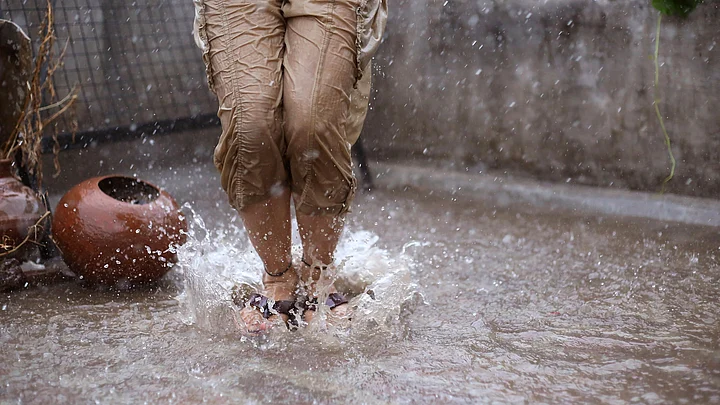This year marks 15 years since Lagaan was released. It has also been fifteen years since I have been observing how the monsoon impacts the urban centres of India and how it impacts Kashmir.
Growing up in Kashmir as a child, I had observed that the monsoon offered little cause for cheer. It was only the first showers of monsoon that were welcomed, bringing respite from the summer. But the constant pitter-patter of raindrops always caused more alarm than delight.
The bowl-shaped Kashmir fills up with water fast. Rather than cheer in the monsoon rain, one has to deal with sudden chill and heavy water-logging on the roads, making movement difficult.
Dreading the Showers
Hailstones in Kashmir are small fry compared to the heavy snowfall we receive every year. More rain causes more anxiety, and calls for fervent prayers for a break from the showers so that water can recede from the roads.
In Delhi, I saw children squealing with delight as hailstones fell on their head. Indulgent parents let them collect the hailstones in bowls, as the little ones ran around the lawns of their house. During monsoon months, the radio would play popular rain songs. I found adults singing the older classics, and the youth humming the more contemporary rain numbers.
Bollywood’s Tryst with Rain
From the songs playing on radio, I discovered that Bollywood has a dedicated rain culture. The songs could be saucy or sad, nostalgic or evocative. But every once in a while, a rain song in a new movie would become the latest delight, and be on everyone’s lips.
The rain culture extended beyond chai and pakoras. In college, I found fellow students playing a new kind of antakshri. One had to sing only songs which featured rain sequences. The sauciest ones would win. The all-time favourite was ‘Ek ladki bheegi bhaagi si’, a classic from Chalti Ka Naam Gaadi which was not saucy but hugely popular.
Among the saucy Bollywood rain songs, the popular entries were Sridevi’s mindblowing Kaate nahin kat te ye din ye raat from Mr India. Then came Amitabh Bachchan seductively wooing Smita Patil with Aaj rapat jaayein from Namakhalaal.
But the runaway winner was the Queen of Oomph, Zeenat Aman, singing Haaye haaye ye majboori in Roti Kapda Aur Makaan. Nobody exuded pizzazz like the Laila of Qurbani.
Romance with Rain Continues
During a recent visit to New Delhi, I found that FM still plays the popular Bollywood saavan songs. Loud, happy demands for chai and pakoras fill houses.
New songs have been added to the rain playlist. Jo haal dil ka from Sarfarosh, Tum se hi from Jab We Met,. Zoobi Doobi from Three Idiots.
So yes, monsoon can cause both alarm and cheer. The devastating flood of 2014 has filled Kashmir with an abiding fear of monsoon showers. Even two days of heavy rain becomes a cause of worry in the Valley.
The urban centers of India grapple with poor planning and drainage infrastructure. Roads get choked with rising water, vehicles are stuck, and motorists are caught in a bind with nowhere to go.
And yet, despite all these infrastructural challenges, the romance with rain continues.
(The writer is a social activist from Jammu and Kashmir and can be reached at @AfanYesvi. This is a personal blog and the views expressed above are the author’s own. The Quint neither endorses nor is responsible for the same.)
Also read:
(At The Quint, we question everything. Play an active role in shaping our journalism by becoming a member today.)
